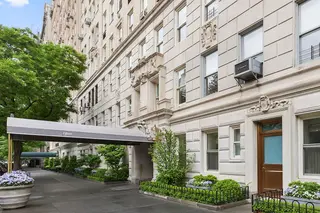 Carter Horsley
Carter HorsleyDec 23, 2011
Carter's Review
One of the city's finest mid-block residential pre-war buildings, 15 West 81st Street was designed by Emery Roth, the architect of the very grand Beresford just two doors to the east.
It is across 81st Street from the enormous American Museum of Natural History and its luminous Rose Center for Earth and Space.
The building has a very broad frontage of 81st Street and also extends through the block to 82nd Street.
The 16-story building has 119 apartments, many of which have very impressive layouts. One six-room apartment, for example, has a 24 by 9 foot reception foyer that opens onto a 27 by 17 foot living room and a 17-foot-square dining room. The apartment also has a 23-foot master bedroom suite, a 16 by 14 second bedroom, a 15 by 11 windowed kitchen and a 10 by 7 maid's room.
The beige-brick building has a 3-story rusticated base, a couple of bandcourses, and an attractive setback watertank enclosure. It has a canopied entrance flanked by lighting sconces and sidewalk landscaping.
The building has a 24-hour doorman, a children's playroom, a gym, storage rooms and an impressive lobby.
It was completed in 1930 and converted to a cooperative in 1966.
There are cross-town buses on 81st Street and a subway station at Central Park West.
There are many restaurants in the neighborhood.
In his February 13, 2000 "Streetscapes" column in The New York Times, Christopher Gray noted that that month's opening of the Rose Center will offer museumgoers "a remarkable view looking out - to the north side of 81st, which started as a street of mansions but became a cliff of apartment towers."
"Sustained building on the edges of what was called Manhattan Square - where the American Museum of Natural History opened its first building in 1877 - began in the mid-1880's," the article said, adding that "It appears that the first houses on the north side of the square were the three at 31, 33 and 35 West 81st Street, of which only No. 33 still stands. These were built by the developer Samuel Colcord, who had served for a few years as a Congregationalist minister. But around 1880, Colcord, his health failing, was advised by his physician to enter ''some outdoor occupation,'' as The New York Times put it in his 1938 obituary, and Colcord built a fortune in real estate from the 1880's to the 1910's. He later put it to use in the cause of pacifism and promoting the League of Nations. Colcord's houses were of astounding variety - the turreted 31, the Queen Anne-style 33 and the Gothic revival 35 West 81st - designed by his regular architect, Henry L. Harris. The first owner of No. 33 was Charles E. Orvis, a banker, who was also New York State Inspector of Rifle Practice. He moved up to Manhattan Square from a house on East 34th Street. Other houses soon began to fill in the block, including a lacy triplet at 25, 27 and 29 West 81st, designed by Berg & Clark for the developer Richard Deeves in 1889. Colcord himself occupied a single-family house next to the original Beresford, an apartment house built in 1889 at the corner of Central Park West."
"After 1900 private-house construction slowed to a trickle," the article continued, "and in 1905 the Hotel Colonial was built at Columbus Avenue, designed by Frederick Browne with a distinctive curved corner. The next tall building was the Bownette, built in 1908 by the chemical manufacturer Samuel W. Bowne at 11 West 81st Street. At 12 stories, it offered full-floor apartments and a swanky, Beaux-Arts-style façade. Around that time Charles Orvis moved from his house at 33 West 81st to No. 35, which he demolished in 1914 for the 12-story apartment building he called the Orvista - but he didn't live there. Around 1917 the developer Edward W. Browning took over the top floor and roof of the Orvista; he custom-built a grand apartment with fountains in the dining room and decorated in a stew of Gothic, French, Japanese, Elizabethan and other styles. He built an elaborate garden on the roof - including a pond big enough for a rowboat, and an early bug zapper that worked with electric lights, a powerful fan and a glass funnel. The childless Browning was nicknamed 'Daddy,' and advertised to adopt young girls from poor families - attracting floods of applicants of mixed motives, applicants often older than they claimed. It appears he had left the Orvista by 1926 when, at age 51, he married 15-year-old Frances (Peaches) Browning. Their relationship lasted 10 months."
"In 1922," the article said, "the Hotel Standish Hall went up at 45 West 81st Street, which despite its Spanish Renaissance design was apparently named for Miles Standish, the New England settler. The last tall buildings on the block were the grand 21-story Beresford, which in 1929 replaced its older namesake at Central Park West, and its junior sibling of 1930, 15 West 81st Street, both designed by Emery Roth."

- Co-op built in 1930
- Converted in 1966
- 2 apartments currently for sale ($2.5M to $7.9M)
- Located in Central Park West
- 119 total apartments 119 total apartments
- 10 recent sales ($885K to $6.7M)
- Doorman
 6sqft delivers the latest on real estate, architecture, and design, straight from New York City.
6sqft delivers the latest on real estate, architecture, and design, straight from New York City.
